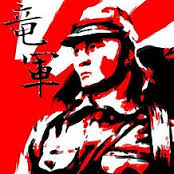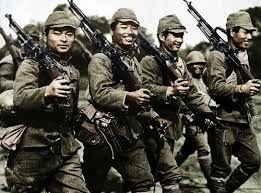Nanking massacre
In December of 1937, the Japanese Imperial Army marched into China's capital city of Nanking and proceeded to murder 300,000 out of 600,000 civilians and soldiers in the city. The six weeks of carnage would become known as the Rape of Nanking and represented the single worst atrocity during the World War II era in either the European or Pacific theaters of war.
 The actual military invasion of Nanking was preceded by a
tough battle at Shanghai that began in the summer of 1937. Chinese forces there
put up surprisingly stiff resistance against the Japanese Army which had
expected an easy victory in China. The Japanese had even bragged they would
conquer all of China in just three months. The stubborn resistance by the
Chinese troops upset that timetable, with the battle dragging on through the
summer into late fall. This infuriated the Japanese and whetted their appetite
for the revenge that was to follow at Nanking.
The actual military invasion of Nanking was preceded by a
tough battle at Shanghai that began in the summer of 1937. Chinese forces there
put up surprisingly stiff resistance against the Japanese Army which had
expected an easy victory in China. The Japanese had even bragged they would
conquer all of China in just three months. The stubborn resistance by the
Chinese troops upset that timetable, with the battle dragging on through the
summer into late fall. This infuriated the Japanese and whetted their appetite
for the revenge that was to follow at Nanking.
After finally defeating the Chinese at Shanghai in November,
50,000 Japanese soldiers then marched on toward Nanking. Unlike the troops at
Shanghai, Chinese soldiers at Nanking were poorly led and loosely organized.
Although they greatly outnumbered the Japanese and had plenty of ammunition,
they withered under the ferocity of the Japanese attack, then engaged in a
chaotic retreat. After just four days of fighting, Japanese troops smashed into
the city on December 13, 1937, with orders issued to "kill all
captives."
Their first concern was to eliminate any threat from the
90,000 Chinese soldiers who surrendered. To the Japanese, surrender was an
unthinkable act of cowardice and the ultimate violation of the rigid code of
military honor drilled into them from childhood onward. Thus they looked upon
Chinese POWs with utter contempt, viewing them as less than human, unworthy of
life.
The elimination of the Chinese POWs began after they were transported
by trucks to remote locations on the outskirts of Nanking. As soon as they were
assembled, the savagery began, with young Japanese soldiers encouraged by their
superiors to inflict maximum pain and suffering upon individual POWs as a way
of toughening themselves up for future battles, and also to eradicate any
civilized notions of mercy. Filmed footage and still photographs taken by the
Japanese themselves document the brutality. Smiling soldiers can be seen
conducting bayonet practice on live prisoners, decapitating them and displaying
severed heads as souvenirs, and proudly standing among mutilated corpses. Some
of the Chinese POWs were simply mowed down by machine-gun fire while others
were tied-up, soaked with gasoline and burned alive.
After the destruction of the POWs, the soldiers turned their
attention to the women of Nanking and an outright animalistic hunt ensued. Old
women over the age of 70 as well as little girls under the age of 8 were
dragged off to be sexually abused. More than 20,000 females (with some
estimates as high as 80,000) were gang-raped by Japanese soldiers, then stabbed
to death with bayonets or shot so they could never bear witness.
Pregnant women were not spared. In several instances, they
were raped, then had their bellies slit open and the fetuses torn out.
Sometimes, after storming into a house and encountering a whole family, the
Japanese forced Chinese men to rape their own daughters, sons to rape their
mothers, and brothers their sisters, while the rest of the family was made to
watch.
 Throughout the city of Nanking, random acts of murder
occurred as soldiers frequently fired their rifles into panicked crowds of
civilians, killing indiscriminately. Other soldiers killed shopkeepers, looted
their stores, then set the buildings on fire after locking people of all ages
inside. They took pleasure in the extraordinary suffering that ensued as the
people desperately tried to escape the flames by climbing onto rooftops or
leaping down onto the street.
Throughout the city of Nanking, random acts of murder
occurred as soldiers frequently fired their rifles into panicked crowds of
civilians, killing indiscriminately. Other soldiers killed shopkeepers, looted
their stores, then set the buildings on fire after locking people of all ages
inside. They took pleasure in the extraordinary suffering that ensued as the
people desperately tried to escape the flames by climbing onto rooftops or
leaping down onto the street.
The incredible carnage - citywide burnings, stabbings,
drownings, strangulations, rapes, thefts, and massive property destruction -
continued unabated for about six weeks, from mid-December 1937 through the
beginning of February 1938. Young or old, male or female, anyone could be shot
on a whim by any Japanese soldier for any reason. Corpses could be seen
everywhere throughout the city. The streets of Nanking were said to literally
have run red with blood.
1
Those who were not killed on the spot were taken to the
outskirts of the city and forced to dig their own graves, large rectangular
pits that would be filled with decapitated corpses resulting from killing
contests the Japanese held among themselves. Other times, the Japanese forced
the Chinese to bury each other alive in the dirt.
After this period of unprecedented violence, the Japanese
eased off somewhat and settled in for the duration of the war. To pacify the
population during the long occupation, highly addictive narcotics, including
opium and heroin, were distributed by Japanese soldiers to the people of
Nanking, regardless of age. An estimated 50,000 persons became addicted to
heroin while many others lost themselves in the city's opium dens.
In addition, the notorious Comfort Women system was
introduced which forced young Chinese women to become slave-prostitutes,
existing solely for the sexual pleasure of Japanese soldiers.
 News reports of the happenings in Nanking appeared in the
official Japanese press and also in the West, as page-one reports in newspapers
such as the New York Times. Japanese news reports reflected the
militaristic mood of the country in which any victory by the Imperial Army
resulting in further expansion of the Japanese empire was celebrated.
Eyewitness reports by Japanese military correspondents concerning the
sufferings of the people of Nanking also appeared. They reflected a mentality
in which the brutal dominance of subjugated or so-called inferior peoples was
considered just. Incredibly, one paper, the Japan Advertiser,
actually published a running count of the heads severed by two officers
involved in a decapitation contest, as if it was some kind of a sporting match.
News reports of the happenings in Nanking appeared in the
official Japanese press and also in the West, as page-one reports in newspapers
such as the New York Times. Japanese news reports reflected the
militaristic mood of the country in which any victory by the Imperial Army
resulting in further expansion of the Japanese empire was celebrated.
Eyewitness reports by Japanese military correspondents concerning the
sufferings of the people of Nanking also appeared. They reflected a mentality
in which the brutal dominance of subjugated or so-called inferior peoples was
considered just. Incredibly, one paper, the Japan Advertiser,
actually published a running count of the heads severed by two officers
involved in a decapitation contest, as if it was some kind of a sporting match.
In the United States, reports published in the New
York Times, Reader's Digest and Time Magazine,
were greeted with skepticism from the American public. The stories smuggled out
of Nanking seemed almost too fantastic to be believed.
Overall, most Americans had only a passing knowledge or
little interest in Asia. Political leaders in both America and Britain remained
overwhelmingly focused on the situation in Europe where Adolf Hitler was
rapidly re-arming Germany while at the same time expanding the borders of the
Nazi Reich through devious political maneuvers.
Back in Nanking, however, all was not lost. An extraordinary
group of about 20 Americans and Europeans remaining in the city, composed of
missionaries, doctors and businessmen, took it upon themselves to establish an
International Safety Zone. Using Red Cross flags, they brazenly declared a 2.5
square-mile area in the middle of the city off limits to the Japanese. On
numerous occasions, they also risked their lives by personally intervening to
prevent the execution of Chinese men or the rape of women and young girls.
These Westerners became the unsung heroes of Nanking,
working day and night to the point of exhaustion to aid the Chinese. They also
wrote down their impressions of the daily scenes they witnessed, with one
describing Nanking as "hell on earth." Another wrote of the Japanese
soldiers: "I did not imagine that such cruel people existed in the modern
world." About 300,000 Chinese civilians took refuge inside their Safety
Zone. Almost all of the people who did not make it into the Zone during the
Rape of Nanking ultimately perished.
source: www.thehistoryplace.com








Comments
Post a Comment